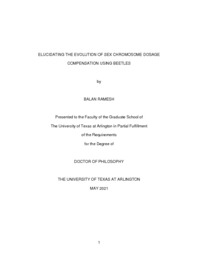
ATTENTION: The works hosted here are being migrated to a new repository that will consolidate resources, improve discoverability, and better show UTA's research impact on the global community. We will update authors as the migration progresses. Please see MavMatrix for more information.
Show simple item record
| dc.contributor.advisor | Demuth, Jeff | |
| dc.creator | Ramesh, Balan | |
| dc.date.accessioned | 2022-07-19T12:16:01Z | |
| dc.date.available | 2022-07-19T12:16:01Z | |
| dc.date.created | 2021-05 | |
| dc.date.issued | 2021-05-04 | |
| dc.date.submitted | May 2021 | |
| dc.identifier.uri | http://hdl.handle.net/10106/30760 | |
| dc.description.abstract | Sex chromosomes are unique because of their role in sex determination. More importantly, sex chromosomes spend an unequal amount of time between the sexes which has significant consequences since it provides an opportunity to understand how evolutionary forces act on the genome. For example, in the XY system of sex determination, males are heterogametic and carry XY chromosomes, whereas females are homogametic and carry XX chromosomes. This difference in the gene dose of X- linked genes between the sexes can be catastrophic for interacting proteins if not balanced. In chapter 1, I introduce the background and current state of understanding for sex chromosome evolution and regulations. In chapter 2, I employ phylogenomics methods to established the phylogeny and divergence time among a group of closely related flour beetles, which provides an evolutionary framework for answering important questions about sex chromosome dosage balance between sexes and compensation considering ancestral state of expression. I find that the broad horned beetle (Gnatocerus cornutus) split from the flour beetles around 122 Million Years Ago (MYA) and the most recent split within flour beetles is around 14 MYA between T.castaneum and T.freemani. In chapter 3, I utilize an X to Autosome fusion in confused flour beetles (Tribolium confusum) combined with the divergence times established in chapter 1 to study the evolution of dosage compensation in flour beetles by reconstructing the ancestral states of neoX-linked gene expression. I report that the neoX and X chromsomes are dosage balanced and compensated. In addition, the expression between the sexes is more tightly regulated and thus dosage balance seems to be more constrained comparing the ancestral autosomal expression with the current state of expression of the sex chromosomes. Lastly, in chapter 4 I employ single-cell RNA-Seq to explore the presence of meiotic sex chromosome inactivation, which affects the expression of X-linked genes during male meiosis. I find that the expression of X-linked genes is repressed or inactivated in most cell clusters hinting towards the presence of MSCI. Comparing the current state of expression with ancestral levels and differentiating expression profile between different types of cells, this dissertation exemplifies the use of comparative transcriptomics to address essential questions in the evolution of sex chromosomes and dosage compensation. | |
| dc.format.mimetype | application/pdf | |
| dc.language.iso | en_US | |
| dc.subject | Sex chromosomes | |
| dc.subject | Dosage compensation | |
| dc.subject | Beetles | |
| dc.subject | Tribolium, scRNA-seq, RNA-seq | |
| dc.title | ELUCIDATING THE EVOLUTION OF SEX CHROMOSOME DOSAGE COMPENSATION USING BEETLES | |
| dc.type | Thesis | |
| dc.degree.department | Biology | |
| dc.degree.name | Doctor of Philosophy in Quantative Biology | |
| dc.date.updated | 2022-07-19T12:16:01Z | |
| thesis.degree.department | Biology | |
| thesis.degree.grantor | The University of Texas at Arlington | |
| thesis.degree.level | Doctoral | |
| thesis.degree.name | Doctor of Philosophy in Quantative Biology | |
| dc.type.material | text | |
Files in this item
- Name:
- RAMESH-DISSERTATION-2021.pdf
- Size:
- 4.700Mb
- Format:
- PDF
This item appears in the following Collection(s)
Show simple item record


